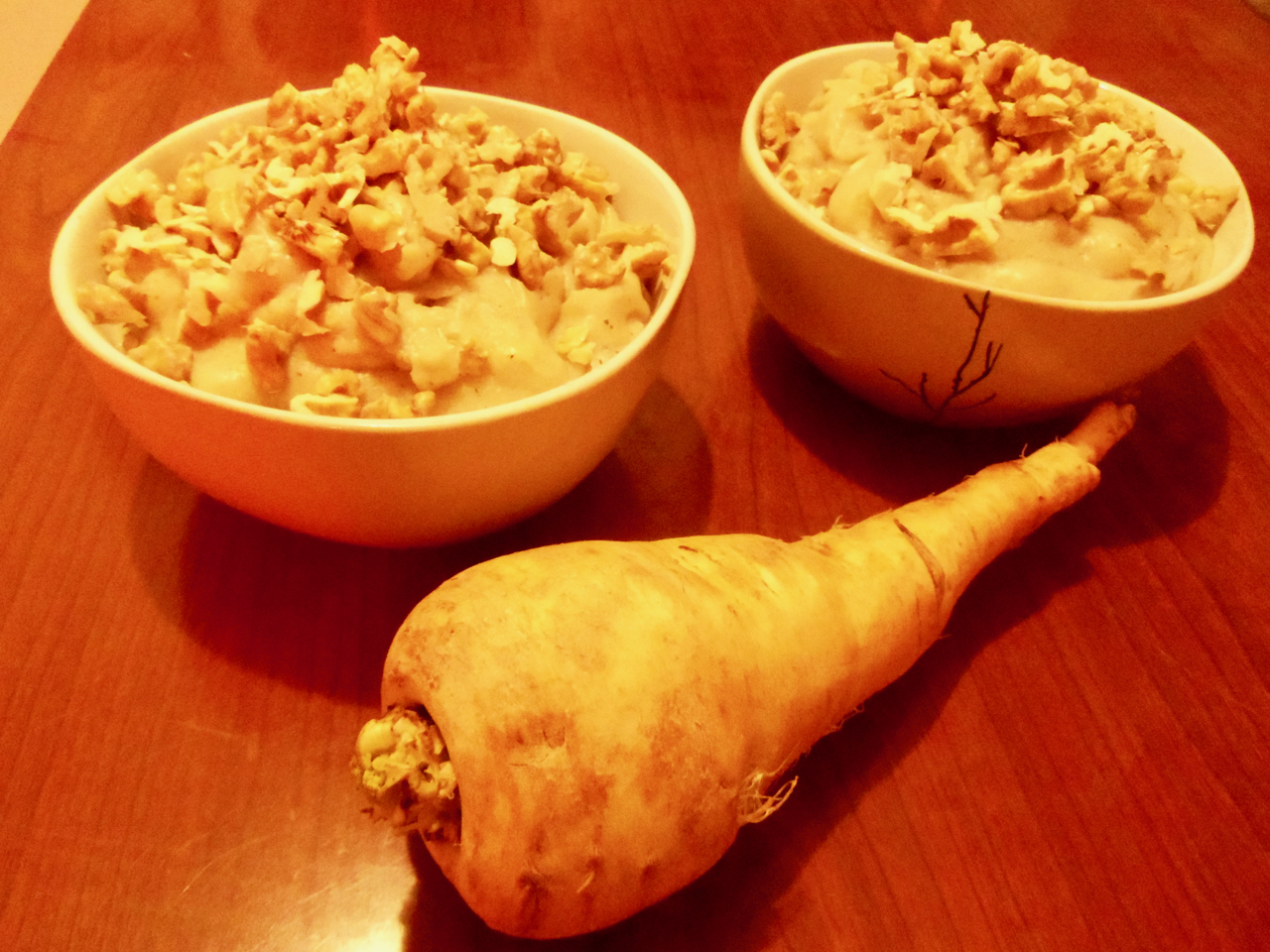Here’s my wife (current) favourite breakfast for managing blood sugar levels without beta-cells…

Parsnip porridge. Actually, it’s so popular I’ve been making Nicole two bowls. One for breakfast. One for lunch (keeps nicely in a warm oven). While porridge for lunch might seem strange, it was quite common to eat porridge three times a day in many different cultures. Even rich old Ebenezer Scrooge, in Dicken’s A Christmas Carol, was enjoying a warm bowl of porridge for dinner when Marley’s ghost visited him.
This recipe contains no animal products, no salt, no oil or sugar (of any kind). In fact, it doesn’t even contain fruit. So it makes for unorthodox breakfast. Ironically, keeping the fructose, sodium and fat to a minimum seems to offer just as good blood sugar control as when Nicole was eating eggs and spinach for breakfast. The final consistency, despite containing no cream or butter, is still creamy (well, at least, very smooth).
Here’s the recipe (two servings) if you’d like to give it a try:
- 8oz (240g) brown rice (we use short-grain)
- 1TB flax seed
- 3 cups (750g) soaking water (for the rice)
- 2oz (60g) pecans or walnuts
- 1/2 cup (125ml) soaking water (for the nuts)
- 3 cups (750ml) cooking water
- 12oz (360g) parsnips, diced
- 1/2 tsp (3ml) dried ginger
- 1/2 stick of cinnamon
- 2 pinches of kelp powder
- 1/2 tsp (3ml) nettle leaves
- (Day before) Rinse and soak the rice and flax seed then soak in water in sealed container.
- Rinse and soak the in water in sealed container.
- (Morning of) Bring cooking water to a boil with parsnips and ginger. Cover and simmer for 90 minutes at low heat. (I place them in the oven at 90oC/200oF and go running.)
- Strain parsnips, retaining the broth.
- Add parsnip broth back to pot. Bring to a boil.
- Grind cinnamon stick in blender.
- Add nettle leaves, kelp, rice and soaking water to blender. Puree on high for two minutes.
- Stir pureed rice mixture from blender into the boiling water.
- Stir constantly until it begins to bubble and thicken.
- Turn off heat and continue stirring for a few minutes.
- Add parsnips and chopped nuts.
To avoid oxidization and make the meal taste truly fresh we grind the rice ourselves instead of buying rice meal. When made with American native pecans Nicole finds it tastes like butterscotch. The nettle leaves are added purely for their medicinal properties (to improve kidney function). The kelp is added as a source of iodine and trace minerals.
This seems like an ideal meal for the long Canadian winters. Even now, in May, we are still using locally grown parsnips. Come summer, however, we might be switching to zucchini. Here are a few alternative ways of making it:
- You can skip soaking the rice (but soaking may save blender time and make it easier to digest).
- You can bring 6 cups of water to a boil and just add freshly ground rice. I find this a bit more work as you need to wash (who knows where it’s been) and dry the rice before grinding it.
- Cardamom, instead of cinnamon, is even more delicious, but also more expensive.
- Nutmeg goes quite well.
- If you want more spice, increase the ginger and/or add black pepper.
- My son and I eat the same, but often swap parsnips for squash, carrots or even rutabaga.
- For a lower-carb version you could try vegetables like cauliflower or zucchini and replace the cinnamon for a more savory herb (like basil or parsley).
- Instead of rice, whole oats are just as nice (but tend to bother gluten-sensitive guts like mine). Millet also works, but is rather bland compared to rice.
- For added sweetness, a little raisins or other dried fruit can be cooked with the parsnips.
- You can easily make it thinner or thicker by adjusting the water. Depending on what type of grain you use will also effect the final consistency.
This dish might taste bland compared to Captain Crunch. And it’s certainly nowhere near as sweet as many of the “healthy” oatmeal recipes you can find on the internet (so drowning in maple syrup, peanut butter and dried fruit that they’re probably dessert rather than breakfast). Nonetheless, once the taste buds adjusted we found this dish delightful.
Thinking outside the T1D Matrix,
–John C. A. Manley
P.S. This qualifies as a SOS-free breakfast. SOS stands for salt, sugar or oil. The term was coined by Dr. Alan Goldhamer of the True North Health Clinic. For more SOS-free recipes check out his Health Promoting Cookbook. It’s one of the few cookbooks we own and use. It’s available from amazon.com, amazon.ca, and amazon.co.uk.
P.P.S. To find out why Nicole switched from a low-carb to a high-carb diet check out: Low-Carb Blues: 5 Reasons We Stopped Cutting the Carbs to Manage Type-1 Diabetes
